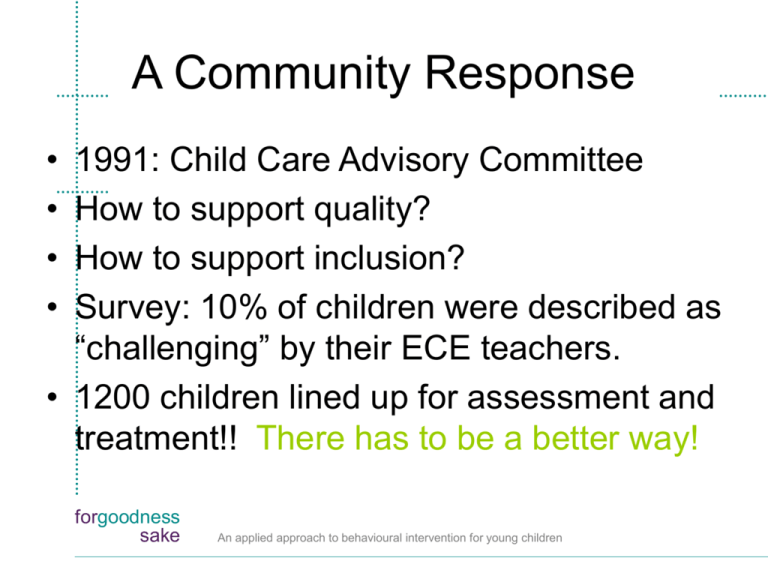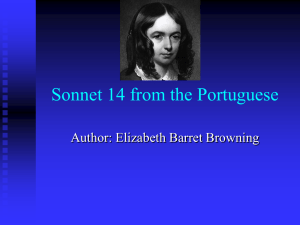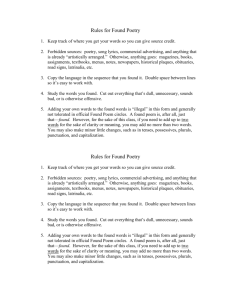For Goodness Sake - Best Start Resource Centre
advertisement

A Community Response • • • • 1991: Child Care Advisory Committee How to support quality? How to support inclusion? Survey: 10% of children were described as “challenging” by their ECE teachers. • 1200 children lined up for assessment and treatment!! There has to be a better way! forgoodness sake An applied approach to behavioural intervention for young children Of the 10% described as challenging… • Very few will be able to access clinical intervention. • And; • Positive relationships are critical for all! forgoodness sake An applied approach to behavioural intervention for young children In the eye of the beholder… forgoodness sake An applied approach to behavioural intervention for young children Behaviour changes as the circumstances change. forgoodness sake An applied approach to behavioural intervention for young children Factors Affecting Behaviour • Child’s development, interests and personality. • Environment – physical • Emotional environment • A need is being met forgoodness sake An applied approach to behavioural intervention for young children The Emotional Environment • • • • Relationships with adults Relationships with peers Feelings of safety and security Stress level Reflect and reframe. forgoodness sake An applied approach to behavioural intervention for young children The Physical Environment • • • • • Toys and equipment Room arrangement Noise level Temperature, light Softness, textures forgoodness sake Environmental Assessment Tools: ECERS-R, ITERS-R, FDCRS An applied approach to behavioural intervention for young children Environment - Structure • • • • Routines Schedule Consistency of caregivers Support for caregivers – training, mentoring, time to plan, time off • Wages and working conditions forgoodness sake An applied approach to behavioural intervention for young children Understand the Child to Understand Behaviour • • • • • • Age Physical development Skills in all areas Health Temperament Emotional state forgoodness sake An applied approach to behavioural intervention for young children Child’s Needs • • • • Attention Help with a developing skill Wants something i.e. toy or object Doesn’t want to do something forgoodness sake An applied approach to behavioural intervention for young children Behaviour to meet needs. • Observe and document • What happens before, during and after the behaviour? • What patterns are repeated? • What is the end result for the child? • Is he/she meeting a need in either a successful way or in a way that is frustrating to the child and adult? forgoodness sake An applied approach to behavioural intervention for young children Typical Behaviour & Typical Strategies • • • • • • • Re-direction Set limits e.g. “when… then” Allow for choice Modelling Tell the child what is expected Acknowledge positive behaviour Attention upfront. forgoodness sake An applied approach to behavioural intervention for young children What is Challenging Behaviour • Behaviour which puts self or others at risk of injury. • Is seriously disruptive: i.e. dealing with behaviour occupies much of teacher’s time. • Continually inhibits positive interactions with peers and adults. • “Challenging behaviour challenges us as adults to adapt the environment and / or the way we interact with the child.” – Setting the Stage for Successful Behaviour forgoodness sake An applied approach to behavioural intervention for young children Five step process • Reflect on your relationship with the child. • Gather information about the child. • Gather information about the environment. • Observe the behaviour. • Develop a plan. • Reflect on progress and re-visit as needed. forgoodness sake An applied approach to behavioural intervention for young children Implementing the plan successfully. • Inform and engage everyone involved. • Define the “new” skill or behaviour. • Set goals – “Reduce frequency of incidents” – “Reduce intensity of incidents”. – “ Increase in use of new skills”. Document to monitor consistency and to measure change. Focus on the positive! forgoodness sake An applied approach to behavioural intervention for young children The power of positive connections. forgoodness sake An applied approach to behavioural intervention for young children Scenario forgoodness sake An applied approach to behavioural intervention for young children forgoodness sake An applied approach to behavioural intervention for young children Dr. Jean Clinton and Lois Saunders forgoodness sake An applied approach to behavioural intervention for young children forgoodness sake An applied approach to behavioural intervention for young children For Goodness Sake Week One Some background For Goodness Sake, An Applied Approach to Behavioural Intervention for Young Children, was developed in Hamilton as a resource for early childhood educators and caregivers who are dealing with challenging and aggressive behaviour among children in their care. With the support of funding from the Ontario Trillium Foundation and the Hamilton Community Foundation, the resource was developed by the Hamilton Early Learning Partners for Best Practice (HELP-BP) and produced by MJM Productions and Electra Communications of Hamilton. forgoodness sake An applied approach to behavioural intervention for young children Why communities need For Goodness Sake For Goodness Sake responds to the need for support in dealing with young children who display challenging and aggressive behaviour. The Early Years Report (McCain, Mustard) indicates that early child development initiatives must include all children, including those living with special difficulties and challenges, yet in many cases, child care has been terminated due to behaviour. Furthermore, disruptive, acting out or aggressive behaviours are the most common reason for referral to children’s health services (Offord, Boyle and Szatmari, 1987). Interventions that focus on training parents and caregivers to modify their interactions with their forgoodness children 2001) have shown success in An applied approach to behavioural intervention for young children sake (Fick, decreasing disruptive behaviours. For Goodness Sake Week Two For Goodness Sake Week Three For Goodness Sake • Fills a service gap in the area of consultation regarding challenging behaviour • Addresses the need in a way that is efficient in terms of deployment of community resources • Supports skill development among parents, caregivers and early childhood educators • Addresses the societal concern that Fraser Mustard speaks to in the Early Years Report, i.e. the urgency of not meeting the needs of our young children and their caregivers, considered to be the forgoodness real brain drain fortoCanadian culture (Early An applied approach behavioural intervention for young children sake Years Report, 1999) For Goodness Sake Week Four For Goodness Sake For Goodness Sake is a resource for early childhood educators, community health nurses and teachers. Through its interactive CD format, For Goodness Sake combines training along with a system to guide practitioners and parents in developing action plans to address challenging behaviour and support pro-sociality. forgoodness sake An applied approach to behavioural intervention for young children For Goodness Sake Week Five Anticipated outcomes • Lessened demand on community mental health consultation services • Improvements in caregiver confidence • Improved school readiness and pro-social skill development forgoodness sake An applied approach to behavioural intervention for young children Evaluation by research team The Research and Evaluation committee of Hamilton Early Learning Partners for Best Practice (HELP-BP) is chaired by Dr. Jean Clinton and includes researchers and epidemiologists from: • McMaster University Department of Psychology • McMaster Children’s Hospital • City of Hamilton Department of Public Health and Community Services, Program Policy and Planning Division. forgoodness sake An applied approach to behavioural intervention for young children For Goodness Sake Week Six Currently under evaluation • Fidelity to training • Change in teachers/caregivers confidence • Change in parents’ confidence in the ability of teachers/caregivers • Child outcomes will be evaluated in conjunction with McMaster University’s Community – University Research Alliance (CURA) Project forgoodness sake An applied approach to behavioural intervention for young children For Goodness Sake Week Seven To order For Goodness Sake: The cost of For Goodness Sake is $200.00. To order a copy for your program contact: Lois Saunders, ECE,C Affiliated Services for Children and Youth forgoodness sake E-mail: saunders@ascy.ca An applied approach to behavioural intervention for young children




